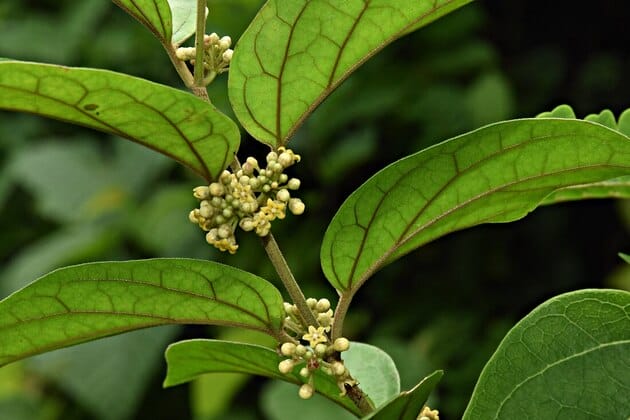Gymnema, Gurmar
Miracle fruit, Sweet Fruit, Australian Cow plantGurmar, Meshashringi (Ayurveda)
Hashishatul Saboon, Gurmar Buti (Unani);
Geng Teng (TCM)
 Gymnema sylvestre
Gymnema sylvestre(Photo by FarEnd2018) (Wikimedia)

Members CLICK HERE for the PRO VERSION
Botanical name:
Gymnema sylvestre
Also used are G. montanum and G. hirsutum
Parts used:
Leaf; rarely the root
Temperature & Taste:
Cool, dry. Bitter
Uses:
1. Clears Heat, Resists Poison:
-acute Cough, acute Sore Throat, Fever (leaf decoction was used by Charaka)
-Sores, Boils, Breast Abscess, Scrofula; Internal Abscess (Sushruta).
-chronic Skin disease
-Jaundice (Sushruta)
-toxic effects of excess alcohol or Opium use
-root decoction is also used against Toxin and poison Insect and Snake bites. (Ayurveda, TCM)
2. Clears Heat, Benefits Yin, Stops Leakage:
-root powder is taken as an astringent.
-Polyuria; Dysuria
-an important Anti-diabetic herb (Diabetes I & II); increases insulin production, enhances glucose tolerance
-Loss of Vision; Corneal Opacity
3. Clears Wind and Damp, Relieves Pain:
-Joint pain and Arthritis from Wind-Damp (TCM)
-Migraine (Ayurveda, Sushruta)
4. Aids Weight Loss:
-special function of temporarily reducing taste, specifically the sweet taste, for which it called Gurmar–‘sugar destroyer’.
-reduces appetite, aids weight reduction and lowers cholesterol.
5. Emetic:
-Root is emetic in full doses.
6. Externally:
-root powder is applied directly to absorb venom of bites and stings (inc. snake)
-root powder is applied directly to Wounds as an absorbent.
-applied topically to swollen glands; roots were applied to Scrofula
-leaf juice has been applied topically as an abrasive for Corneal Opacity.
-as a collyrium to improve eyesight (Sushruta)
-topically for Leukoderma.
Dose
Powder: 1–3 grams, up to 5 grams;
Correctives:
… available in PRO version
Substitutes:
… available in PRO version

Main Combinations:
1. Diabetes, and to regulate Blood Sugar:
i. Gymnema with
… available in PRO version
ii. balance blood sugar, especially Phlegm types, Gymnema with
… available in PRO version
iii. Gymnema with
… available in PRO version
iv. Gymnema with
… available in PRO version
v. Gymnema,
… available in PRO version
v. Gymnema with
… available in PRO version
vi. Gymnema combines well with
… available in PRO version
vii. Gymnema with
… available in PRO version
viii. Gymnema with
… available in PRO version
ix. Gymnema with
… available in PRO version
2. To clear Heat and Toxin from the Blood, Gymnema with
… available in PRO version
Cautions:
Generally Safe. Long-term toxicity tests in animals have shown no detrimental effects.
1. Not used (or used cautiously) in Hypoglycemia.
2. Monitor Blood sugar levels in Diabetic patients taking western medication.
Main Preparations used:
-
Extra Info
- History
|
This shrubby climbing plant is called Meshasringi, “ram’s horn,” in Sanskrit, but it is not mentioned in the Raja Nirghanta. It is considered to be the Meshasringi of Madanpal’s Nighanta and of the Marathi and Guzerathi Nighantas, which are little more than translations of that work. It bears the following synonyms— Mesha vishanika, Meshavalli, Sarpa-darushtrika, Anyada, Kshina-vartta, Vrik-shikali and Vishanika, and is described as having a pungent taste and the properties of an astringent and bitter stomachic; useful in cough, biliousness, boils, sore eyes, &c. It is also in repute amongst the Hindus as a remedy for snake bite, the powdered root being applied to the part bitten, and a decoction administered internally. Its use for this purpose is well known to the natives of the Concan, and as appears from Ainslie {Mat. Ind. II., 390) also to the natives of Southern India. The root is also said to have virtues similar to Ipecacuanha. Roxburgh describes the plant under the name of Asclepiaa geminata, and remarks that the small yellow flowers, with the globular apex of the white common stigma, projecting in the centre, look like fine pearls set in gold. He says nothing of its medicinal properties. G. sylvestre is said to be the binnuge of the Cingalese. A curious circumstance connected with this plant was first noticed by Mr. Edgeworth, namely, that if chewed it destroys the power of the tongue to appreciate the taste of sugar and all saccharine substances. This property of the leaves has been recently (1887) tested carefully by Mr. D. Hooper, who |
says:— “After chewing one or two leaves it was proved undoubtedly that sugar had no taste immediately afterwards. Sugar in combination with other compounds in dietetic articles is plainly destroyed as to its taste after using these leaves. In gingerbread, for instance, the pungency of the ginger is alone detected, the rest is tasteless meal; in a sweet orange the taste of the sugar is so suppressed and that of the citric acid consequently developed, that in eating, it resembles a lime in sourness. Among the several kinds of foods, drugs and beverages which affect the palate, Gymnema does not pretend to render them all tasteless, it does not affect pungent saline things, astringents and acids. It is limited to apparently two diverse substances— sweets and bitters. It has been noted that sugar taken after the leaf tastes like sand, so I have found that sulphate of quinine taken after a good dose of the leaf tastes like so much chalk. I am not going to propose its use in the administration of nauseous drugs, until the medical properties of the Gymnema have been more studied, otherwise the quantity of the vehicle taken may prove to counteract the effect of the medicines. The experience of several friends as well as my own is that the effect does not last for twenty-four hours as stated, but for only one or two hours, after that time the tongue resumes its appreciation of all that is sweet or bitter.” In the Concan the dried and powdered leaf is used as an errhine, and the fresh leaves crushed and mixed with water, as a cooling bath for children in the hot weather’. (Pharmacographia Indica, Dymock, 1891) |
